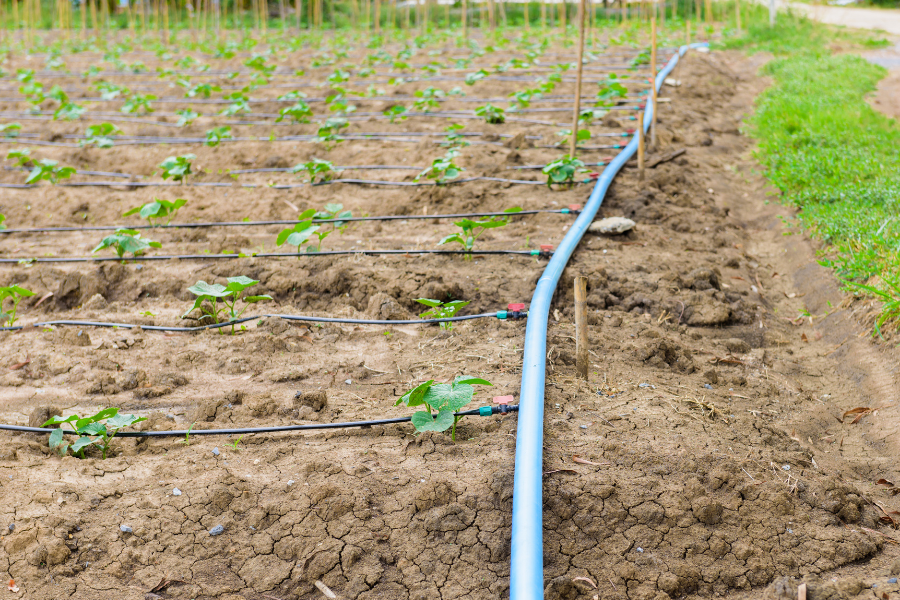Posted On: October 16, 2023
Posted By: KSNM Drip

Have you ever wondered how farmers manage to grow those lush, healthy crops you see in fields? One secret to their success is something called "drip irrigation." In this blog post, we'll dive into the world of drip irrigation, explaining what it is, how it works, and why it's an awesome choice for anyone looking to save water and grow thriving plants.
Drip irrigation is a method of watering plants by delivering small, controlled amounts of water directly to their root zones. It's like giving your plants a drink with a straw rather than pouring water all over them.
A. Emitters: These are the heart of the system. Emitters release water slowly, drop by drop, near the plants' roots. They come in various types, including drip tubing, hoses, or pipes with tiny holes or nozzles.
B. Tubing or Pipes: These carry water from the water source (like a hose or a water tank) to the emitters. The tubing is usually made of flexible materials, making it easy to lay out in your garden.
C. Filters and Regulators: To keep the system clog-free and ensure a consistent flow of water, filters and regulators are often used. Filters trap debris, while regulators maintain the pressure at the right level.
Now that you know what drip irrigation is and how it works, let's explore why it's a fantastic choice for your garden:
Drip irrigation is like the "water-saving superhero" of gardening. It delivers water directly to the roots, reducing water waste through evaporation and runoff. This method can save up to 60% more water compared to traditional watering techniques, making it an eco-friendly choice.
Plants love consistency, and drip irrigation provides just that. By delivering water evenly to the root zone, helps plants grow healthier, with fewer problems like overwatering or underwatering.
Once you set up a drip irrigation system, it does most of the work for you. Say goodbye to the hassle of dragging hoses around the garden or standing in the scorching sun with a watering can.
Ready to give drip irrigation a try? Here's a simplified guide to setting up your system:
Sketch your garden layout, marking where your plants are and where you'll place the tubing and emitters. This step ensures you buy the right materials and use them efficiently.
You'll need emitters, tubing or pipes, connectors, stakes (to hold the tubing in place), filters, and a pressure regulator. Gather all these materials before you start.
Attach emitters to the tubing or pipes where your plants are. Make sure the emitters are close enough to cover the entire root zone but not so close that they create puddles.
Lay out the tubing according to your garden plan. Use connectors to join pieces of tubing and stakes to secure them in place.
Place filters and regulators as needed to keep your system running smoothly.
Before leaving your system unattended, test it to ensure water flows properly to all emitters.
There are several common mistakes that people often make when setting up and maintaining drip irrigation systems. To ensure your drip irrigation system works effectively, here are five mistakes to avoid:
Mistake: Not planning or designing your drip irrigation system properly.
Solution: Before installing a drip system, carefully plan and design it based on your garden's layout, plant types, and water requirements. Consider the placement of emitters or tubing to ensure even water distribution.
Mistake: Placing emitters too close or too far from plants or using the wrong type of emitter for specific plants.
Solution: Research the water needs of your plants and place emitters accordingly. Regularly check their placement to accommodate plant growth.
Mistake: Neglecting routine maintenance of the system.
Solution: Drip irrigation systems require regular maintenance to function efficiently. Clean filters, remove clogs and check for leaks or damaged components.
Mistake: Allowing the system to overwater or underwater your plants.
Solution: Monitor your plants' water needs and adjust the drip system accordingly. Avoid overwatering or underwatering.
Mistake: Using cheap or low-quality drip irrigation components.
Solution: Invest in high-quality drip irrigation components to ensure durability and longevity. Low-quality materials can deteriorate quickly and lead to leaks or inefficient water distribution. Quality components may cost more upfront but will save you money and frustration in the long run.
Bonus Tip: Mulch around your plants to help retain moisture, reduce evaporation, and minimize weed growth. This can complement your drip irrigation system and improve water efficiency.
By avoiding these common mistakes you can ensure that your drip irrigation system effectively provides your plants with the right amount of water while conserving the precious resource.
Here are some tips to make your drip irrigation journey even smoother:
Inspect your system regularly to spot and fix any clogs, leaks, or damaged parts.
As your plants grow, you might need to move or add emitters to ensure they receive enough water.
Consider using a timer to control when your system waters your plants. Early morning is usually the best time to water.
Drip irrigation isn't just for professional farmers; it's an accessible and efficient way to keep your garden thriving while saving water and time. Delivering water directly to plant roots, it's a win-win for both you and your green friends. So, next time you're tending to your garden, think about making the switch to drip irrigation and watch your plants flourish like never before. Happy gardening!